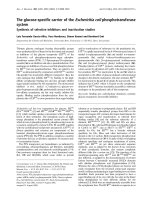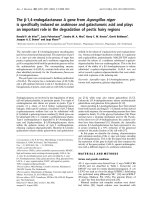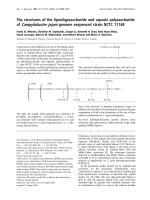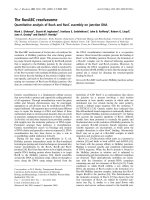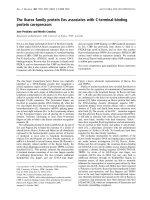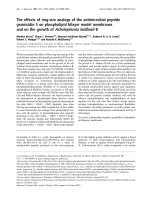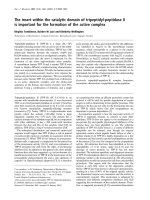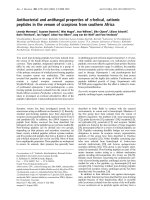Báo cáo Y học: The DNA-polymerase inhibiting activity of poly(b-L-malic acid) in nuclear extract during the cell cycle of Physarum polycephalum pot
Bạn đang xem bản rút gọn của tài liệu. Xem và tải ngay bản đầy đủ của tài liệu tại đây (194.24 KB, 6 trang )
The DNA-polymerase inhibiting activity of poly(b-
L
-malic acid)
in nuclear extract during the cell cycle of
Physarum polycephalum
Sabine Doerhoefer
1
, Christina Windisch
1
, Bernhard Angerer
1
, Olga I. Lavrik
2
, Bong-Seop Lee
1
and Eggehard Holler
1
1
Institut fu
¨
r Biophysik und physikalische Biochemie, Universita
¨
t, Regensburg, Germany;
2
Novosibirsk Institute of Biorganic Chemistry,
Siberian Division of the Russian Academy of Sciences, Novosibirsk, Russia
The naturally synchronous plasmodia of myxomycetes
synthesize poly(b-
L
-malic acid), which carries out cell-spe-
cific functions. In Physarum polycephalum,poly(b-
L
-malate)
[the salt form of poly(b-
L
-malic acid)] is highly concentrated
in the nuclei, repressing DNA synthetic activity of DNA
polymerases by the formation of reversible complexes. To
test whether this inhibitory ac tivity is cell-cycle-dependent,
purified DNA polymerase a of P. polycephalum was added
to the nuclear extract and the activity was measured by the
incorporation of [
3
H]thymidine 5¢-monophosphate into acid
precipitable nick-activated salmon testis DNA. Maximum
DNA synthesis by the reporter was measured in S-phase,
equivalent to a minimum of inhibitory activity. To t est for
the activity of endogenous DNA polymerases, DNA syn-
thesis was followed by the highly sensitive photoaffinity
labeling technique. Labeling was observed i n S-phase in
agreement with the minimum of the inhibitory activity. The
activity was constant throughout the c ell cycle when the
inhibition was neutralized by the addition of spermidine
hydrochloride. Also, the concentration of poly( b-
L
-malate)
did not vary with the phase of the cell cycle [Schmidt, A.,
Windisch, C. & Holler, E. (1996) Nuclear accumulation and
homeostasis of the unusual polymer poly(b-
L
-malate) in
plasmodia of Physarum polycephalum. Eur. J. Cell Biol. 70,
373–380]. To explain the variation i n the cell cycle, a p eriodic
competition for poly( b-
L
-malate) between DN A polym-
erases and most likely certain histones was assumed.
These effectors are synthesized in S-phase. By c ompeti-
tion they displace DNA polymerase from the complex of
poly(b-
L
-malate). The free polymerases, which are no longer
inhibited, engage in DNA synthesis. It is speculated that
poly(b-
L
-malate) is active in maintaining mitotic synchrony
of plasmodia b y playing the mediator between the periodic
synthesis of certain proteins and the catalytic competence of
DNA po lymerases.
Keywords: poly(malic acid); cell cycle; S-phase; DNA syn-
thesis; h istones.
Poly(b-
L
-malic acid) consists of
L
-malic acid units, which are
covalently linked by ester bonds between the hydroxyl
group and the carboxyl group in the b position, while the
carboxyl group in a position points away from the polyester
chain [1]. The ionized form of the polymer, poly(b-
L
-malate)
(PMLA), amounts to high concentrations comparable to
DNA in the naturally synchronous nuclei of the plasmo-
dium, the giant polynuclear cell form of the slime mould
Physarum polycephalum [1–3]. This organism differentiates
into several cell forms during its life cycle (e.g. spores and
amoebae) [4], but only the plasmodium produces poly(b-
L
-malic acid). In contrast to the giant cell dimensions, the
billions of nuclei display cyclic events, such as mitosis and
DNA replication, with a high degree o f natural synchrony.
Because of these featu res, the plasmodium is suited for
studying molecular biology of the cell cycle. One particular
question is the organization of the catalytic competence of
DNA polymerases in the context of synchrony.
Poly(b-
L
-malate) was discovered by its activity to bind
and reversibly inactivate the endogeneous DNA polymerase
a [1,5]. The other replicatively active DNA polymerases
(types d and e)havealsobeenshowntobindandbecome
inactivated, whereas the putative repair enzyme, DNA
polymerase b-like, was not inhibited [6,7]. Binding experi-
ments with synthetic polyanions, which differed from
PMLA in the distance between the negative charges,
demonstrated that specific ity of binding is a ttributed to
the particular distance b etween the n egative charges in
PMLA [5]. This distance is similar to that between
phosphate groups in the nucleic acid backbone, in agree-
ment with the competitive binding of PMLA and DNA to
the polymerases. The molecular mimicry suggested that
PMLA could bind to histones and to other DNA interact-
ing proteins. Indeed, large complexes of PMLA not only
with DNA polymerases but also with histones and other
proteins have been found under conditions close to in vivo
[2,7]. The binding to histones has been further investigated
by in vitro experiments [5].
If histones and DNA polymerases are together, they are
prone to compete for the binding to PMLA. The periodic
Correspondence to E. Holler, Institut fu
¨
r Biophysik und physikalische
Biochemie der Universita
¨
t Regensburg, D-93040 Regensburg,
Germany. Fax: + 49 941943 2813, Tel.: + 49 941943 3030,
E-mail:
Abbreviations: AFBdCTP, exo-N-{[[((4-azido-2,3,5,6-tetra-
fluorobenzylidene)hydrazino)carbonyl]butyl]carbonyl}deoxycytidine-
5¢-triphosphate; PMLA, poly(b-
L
-malate).
Enzymes: D NA polymerase (E.C. 2.7.7.7); benzonase (E.C. 3.1.21.1).
Note: a website is available at h ttp://www.biologie.uni-regensburg.de/
Biophysik
(Received 8 O ctober 2001, revised 27 December 2001, accepted
7 January 2002)
Eur. J. Biochem. 269, 1253–1258 (2002) Ó FEBS 2002
production of histones (or of any other PMLA-binding
molecule) in S-phase could evoke a cycling of free DNA
polymerases and DNA synthetic a ctivity, although the
individual levels of PMLA and DNA polymerases need not
vary. For a p roper understanding of the role of PMLA it
was thus interesting to know its inhibitory activity over the
cell cycle. Because the inhibitory activity could not be tested
under in vivo conditions, experiments were carried out with
nuclear extracts. The results were consistent with the
assumption that PMLA was a mediator between increased
concentrations of certain nuclear constituents and the
competence of DNA polymerases in DNA synthesis during
S-phase.
MATERIALS AND METHODS
Materials
Microplasmodia of P. polycephalum,strainM
3
CVIII
(ATCC 96951), were grown in shaken cultures at 27 °C, as
described p reviously [8]. Macroplasmodia were obtained as
surface cultures on fi lter paper by the fusion of mi cro-
plasmodia, as described previously [9]. The mitotic stages
were identified b y phase-co ntrast m icroscopy [10]. O ne gram
of wet plasmodia corresponded to % 2 · 10
8
nuclei. DNA
polymerase a (110 UÆmL
)1
) was purified from plasmodia as
described previously [11]. DNase-I-activated salmon testis
DNA for the s tandard DNA polymerase a ssay and for
photoaffinity labeling was prepared as described previously
[12]. Rabbit antiserum against DNA polymerases type a
and type e, was prepare d with a m ixture of the purified
P. polycephalum DNA polymerases [13], a nd rabbit anti-
serum against DNA polymerase d by immunization with
synthetic peptides of the enzyme [6]. Peroxidase-coupled
anti-(rabbit IgG) Ig was purchased from Pierce. Proteinase
inhibitors were used in a cocktail of the following
concentrations after dilution with the e xtracts: 5 m
M
sodium
bisulfite, 0.2 m
M
phenylmethanesulfonyl fluoride, 1 m
M
benzamidine (Sigma), 1 l
M
pepstatin A (Merck), 10 l
M
leu-
peptin (Sigma), 1 mgÆmL
)1
aprotinin (Merck), 10 l
M
tosyl-
L
-lysine chloromethyl ketone (Calbiochem), 100 l
M
pefablock S C (Merck), and 2 lgÆmL
)1
E 64 (Boehringer
Mannheim). For photocrosslinking, the dCTP analogue
exo-N-{[[((4-azido-2,3,5,6-tetrafluorobenzylidene)hydrazi-
no)carbonyl]butyl]carbonyl}deoxycytidine-5¢-triphosphate
(AFBdCTP) was prepared as described previously [14], and
was a gift from Safronov (Novosibirsk). Benzonase grade II
(25 0 00 UÆmL
)1
) was purchased from Merck. Nonradio-
active dNTPs and standard proteins for SDS/PAGE
were obtained from P harmacia (Sweden). [
3
H]dTTP
(60 CiÆmmol
)1
,1Ci¼37 GBq) and [a-
32
P]dATP
(3000 CiÆmmol
)1
) were purchased from Amersham.
Preparation of nuclear extract
Nuclei were prepared either from macroplasmodia follow-
ing their third mitosis, or from microplasmodia harvested
after 2 days of inoculation. The plasmodia were washed by
centrifugation (500 g,10min,4°C) in cold water, suspen-
ded in disruption buffer (2 g of solvent per 1 g o f wet
plasmodia; 15 m
M
Tris/HCl pH 7.5, 5 m
M
EGTA, 0.5 m
M
CaCl
2
,15 m
M
MgCl
2
, 500 m
M
hexylenglycol, 10% dextran,
14 m
M
2-mercaptoethanol, and p rotease inhibitor c ocktail)
and disrupted in a Dounce homogenizer (10–12 strokes).
Nuclei were pellete d over a 25% Percoll g radient in t he
above buffer, as described previously [2]. The pellet
contained 2 ± 1 · 10
8
nuclei per g of wet m icroplasmodia.
Nuclear extracts were prepared by incubating for 10 min on
ice in an equal volume of extraction buffer (final concen-
trations 50 m
M
Tris/HCl pH 7.5, 0.3
M
KCl, 20 m
M
MgCl
2
, 0 .5% T riton X-100, 20% glycerol, 1 m
M
2-merca-
ptoethanol, protease inhibitor cocktail) and centrifugation
at 700 g. The nuclear extract contained > 85% o f the total
nuclear PMLA and > 75% o f t he total nuclear DNA
polymerase activity in the standard assay. Results by SDS/
PAGE and Western blotting with specific antisera against
DNA polymerases a and e [13], and DNA polymerase d [14]
were consistent with the recovery of > 95% of DNA
polymerase a and > 75% of the other DNA polymerases in
the extract.
Standard DNA polymerase activity and inhibition assays
Total DNA polymerase activity was assayed as described
previously [12]. The standard assay contained in 150 lL
50 m
M
3-(N-morpholino)propanesulfonic acid/potassium
salt (pH 7.5), 50 m
M
KCl, 10 m
M
MgCl
2
,3m
M
EDTA,
3m
M
2-mercaptoethanol, 3 3 l
M
each of dATP, dCTP,
dGTP, 3 l
M
[
3
H]dTTP (1 CiÆmmol
)1
), 20 lg DNase-I
activated salmon testis DNA, 80 lg bovine serum albumin,
and DNA polymerase. After a 30-min lcubation at 37 °C,
10% (v/v) saturated cold trichlo roacetic acid in water w as
added and the precipitate collected on Whatman GF/C
filters, which were washed with trichloroacetic acid, then
with 70% (v/v) ethanol/H
2
O dried, and counted with 20%
efficiency. If r equired, either 0 .4 m
M
spermineÆ4HCl or
2m
M
spermidineÆ3HCl were included to suppress binding
and inhibition of polymerases by PMLA [1]. One unit of
polymerase activity is equivalent to the amount of enzyme
that catalyses the incorporation of 1 nmol nucleotides
during 1 h.
The same conditions were used in the inhibition experi-
ments, except that the biogenic amines were omitted. To
measure the inhibitory activity of n uclear extracts during t he
cell cycle, 0.4 U of purified DNA polymerase a was present
in the assay under the above standard conditions comparing
the reaction rates in the presence (v
i
) and the absence
(reference, v
o
) of nuclear extract equivalent to 1.5 · 10
5
nuclei. To account for effects of particular ingredients in the
extract buffer, appropriate amounts of these reagents were
added to t he reference reaction mixture. The low poly-
merase activity contained in t he extract due to DNA
polymerase b-like (which was not inhibited by PMLA)
was measured in parallel and subtracted from the crude
value for v
i
. The inhibitory activity is defined in terms of
the reciprocal value of the inhibition constant K
À 1
i
¼
[E–PMLA]/[E]Æ[PMLA]. The concentration of the poly-
merase–inhibitor complex, [E–PMLA], can be expressed i n
terms of [E]
o
) [E]. The concentration of free polymerase,
[E], and of the total polymerase [E]
o
is proportional to v
i
and
v
o
. The expression for the relative inhibitory activity is then
(v
o
) v
i
)/v
i
¼ [PMLA]/K
i
. Therefore, the higher the con-
centration of free PMLA, and the lower the value of the
inhibition constant (K
i
), the higher the relative inhibitory
activity (v
o
) v
i
)/v
i
. In the presence of ligands that bind com-
petitively to PMLA, the value of K
i
increases as a function
1254 S. Doerhoefer et al. (Eur. J. Biochem. 269) Ó FEBS 2002
of rising concentrations and a ffinities of these ligands. For
example, if spermine hydrochloride, which binds to PMLA,
is present, the inhibition may b e totally neutralized. The
reciprocal of the direct value s of the relative inh ibitory
activity will be shown in the results, as they correlate directly
with the degree of residual DNA polymerase activity.
DNA replication of single macroplasmodia w as followed
under in vivo conditions at various phases in the cell cycle.
The plasmodia were grown on filter paper for a particular
period of time in the cell cycle. One fourth of the
plasmodium, usually 80 lg, was transferred to fresh
medium containing 5 lCiÆmL
)1
[methyl-
3
H]thymidine
(25 CiÆmmol
)1
) and grown for 15 min at 27 °C. The
remainder was allowed to grow and used as the source of
further samples. The incubation was terminated by fixation
in a 10-mL solution containing ice-cold 5% saturated
trichoroacetic acid and 50% acetone. The samples were
disrupted in a Dounce homogenizer and filtered on GF/C.
After washing with trichloroacetic acid/acetone and etha-
nol, the filters were dried, and the radioactivity was counted
in a scintillation cocktail.
Photoaffinity labeling of DNA polymerases
Labeling o f DNA polymerases was carried out in a 20-lL
solution containing 5 lL nuclear extract, 3–5 l
M
[
32
P]dATP
(3000 CiÆmmol
)1
), 125 l
M
AFBdCTP, 33 l
M
of each
dGTP and dTTP, 50 m
M
3-(N-morpholino)propanesulfonic
acid buffer (pH 7.5), 50 m
M
KCl, 10 m
M
MgCl
2
,3m
M
EDTA and 5 lg activated salmon testis DNA [7]. Escheri-
chia coli DNA polymerase I served as a positive control in a
parallel, but oth erwise identical, reaction mixture. In other
control reactions, to exclude staining due to DNA poly-
merase adenylation or phosphorylation, the photoreactive
nucleotide was omitted. The polymerization reaction was
carried out in the dark for 10 min at 37 °C. An aliquot was
then irradiated for 2 min. Free DNA and DNA protruding
from crosslinked complexes with proteins were digested
with benzonase (25 U per sample) for 10–15 min a t 37 °C.
The sample was heated for 3 min with Laemmli buffer [15]
and e xamined b y denaturating SDS/PAGE (10% poly-
acrylamide gel). Proteins were electroblotted onto Millipore
Immobilon membranes [16] and visualized by autoradio-
graphy (Kodak X-OMAT LS) at )70 ° (5–7 days). The
identities of blotted proteins were verified by immunostain-
ing of the same membranes. Intensities of bands were
quantified with a Boehringer Mannheim Lumi Imager
TM
.
The intensity of labeled E. coli DNA polymerase I in the
same gel served as a reference.
RESULTS
Finding optimal assay conditions to measure
the inhibitory activity in nuclear extracts
In previous analytical and preparative experiments, it has
been shown that PMLA was the constituent that s pecific-
ally inhibited replicative DNA polymerases in nuclear
extracts [1,2,7]. In the present study, we measured the
inhibitory activity of PMLA using purified DNA poly-
merase a of P. polycephalum as an added reporter. To find
the optimal assay conditions, t he extracts were prepared
from the nuclei of microplasmodia that naturally included
all phases o f the c ell cycle. As considered in Materials and
methods, t he degree of inhibition depends on both the
concentration of free PMLA and the inhibition constant.
This parameter reflected the affinity of the polymerase and
both the affinity and concentration of competing ligands
for binding to the polyanion. In the (added) nuclear extract,
such ligands were histones, and probably other DNA-
binding proteins [2]. T o obtain an optimal response by the
reporter polymerase to a varying i nhibitory activity in the
nuclear extract, the amounts o f the added polymerase a nd
extract had to be optimized. To this end, the titration of a
fixed amount of nuclear extract, c orresponding to 1.5 · 10
5
nuclei, was performed in the first experiment (Fig. 1). In the
beginning of the titration, the polymerase activity remain ed
suppressed until the inhibitory activity was neutralized by
an amount of 0.38 ± 0.03 U of the reporter DNA
polymerase (the arrow in Fig. 1). During continued addi-
tion of the polymerase, the enzyme a ctivity increased in
parallel with the activity of the control experiment in the
absence of extract. An a mount of 0.4 U of the r eporter
DNA polymerase, close to the neutralization point, was
chosen for the measurement o f the inhibitory activity
during t he cell cycle.
We have previously shown that the inhibitory activity of
purified PMLA is neutralized in the presence 0.4 m
M
spermine hydrochloride [1]. To confirm t hat PMLA was
the only inhibitor of DNA polymerases in the extract above,
we measured the polymerase activity in the presence of
added spermine hydrochloride. A value of 1.2 ± 0.03 U
(five measurements) was ob se rved and r eferred t o the
endogenous DNA polymerases. The experiment was repea-
ted with the extract containing in addition 0.4 U reporter
DNA polymerase a. A n amount of 1.6 ± 0.03 U was
measured in this case (five measurements). The difference of
0.4 ± 0.04 U was in agreement with the added 0.4 U. The
same results were obtained when nuclear extracts in the
S-phase and in G2-phase were compared. The agreement
was consistent with the assumption that the inhibitory
activity was a property of PMLA in the extract.
Fig. 1. The inhibition of purified DNA polymerase a by po ly(b-
L
-
malate) in the nuclear extract. (d) The activity was measured as a
function of added a mounts of DNA polymerase a in the standard
DNA polymerase assay that contained the extract of 2 · 10
6
nuclei
isolated from microplasmodia. (j) The control in the absence of
the nuclear extract containing an equivalent of the ingredients in the
nuclear e xtraction buffer. The arrow refers to the equivalence of
the added DNA p olymerase activity and t he inhibitory activity.
Ó FEBS 2002 Poly(b-
L
-malate) mediated DNA polymerase activity (Eur. J. Biochem. 269) 1255
The inhibitory activity during the cell cycle
The inhibitory activity during the cell cycle was measured in
the p resence of 0.4 U of (added) purified DNA polymerase
a and the extract of 1.5 · 10
5
nuclei. The dependence is
shown in Fig. 2A in terms of the reciprocal values,
corresponding to the residual DNA polymerase activity.
The m aximum at 1 h after m itosis corresponded t o a
minimum in inhibitory activity and a maximum i n t he
residual polymerase a ctivity (63% of the reference activity).
After 2 h following mitosis and during the remainder of t he
cell cycle, the polymerase activity approached a basal level
of 10–20% of the reference activity.
The activity of DNA polymerases measured
by photo affinity labeling
According to Fig. 2A, the inhibitory activity in the nuclear
extract s howed a minimum between 0 and 2 h after mitosis
(Fig. 2 A). It was of interest whether this interval coincided
with some endogenous residual activity of the DNA
polymerases in the n uclear extract (DNA polymerase a
not added). Because t he (residual) activity of the e ndo-
genous DNA polymerases was too low to be detected with
the standard assay, we introduced a highly sensitive
technique of affinity photo crosslinking [7]. Briefly, the
enzymatically active DNA polymerase c atalysed the primer
elongation w ith r adioactively labeled nucleotides o f h igh
specific radioactivity. Then , the e longated primers w ere
photo crosslinked to the active polymerases within the
elongation complex. The amount of radioactivity covalently
attached to DNA polymerases was an i ndicator of the
polymerase activity and was measured after SDS/PAGE by
autoradiography. S eparate results are shown in Fig. 2C for
DNA polymerase e and for DNA polymerases of type a,
type-b-like, and type d in Fig. 2B, which were not resolved
from each other. DNA polymerase e showed the highest
activity during the first hour after mitosis. Then the activity
Fig. 2. DNA polymerase activitiy during the cell cycle of macroplasmodia. All graphs are drawn to the same scale to facilitate comparison. In this
scale, the measured value at 0.7 h in the nuclear division c ycle is arbitrarily set equal to one u nit in each panel. M denotes m itosis. (A) The reciprocal
inhibitory activity v
i
(v
o
) v
i
)
)1
(see text) calculated from values of the r esidual polymerase activity (v
i
) and the reference activity (v
o
)ofadded0.4 U
of purified DNA po lymerase a in the standard DNA polymerase assay with (v
i
) and without (v
o
) nuclear extract. The extract of 2 · 10
6
nuclei was
prepared from macroplasmodia at various times during the cell cycle. Bars refer to standard deviations (three determinations). One unit on scale
refers to 1.64 U of th e recip rocal in hibitory activity. (B) Activity o f endo geno us D NA polymerases a, d,andb-like in the nuclea r e xtract, measured
in arbitrary units (staining intensity) by the highly sensitive technique o f photoaffinity labeling. Single types of DNA polymerases could n ot be
resolved. Bars refer to standard deviations (three determinations). (C) Activity of endogenous DNA polymerase e, measured in parallel with t he
DNA polymerases in panel B. One u nit o n scale compares to half a unit in (B). (D) DNA synthesizing activity o f plasmodia at various times in the
cell cycle. The incorporation of radioactivity into acid precipitable material has been measured during a brief exposure to [methyl-
3
H]thymidine.
One u nit on scale refers to 6 Bq [
3
H]TMP incorporated. (E) The activity of endogenous D NA polymerases in the extract o f 2 · 10
8
nuclei at various
times during the cell cycle. One unit on scale refers to 90 U of DNA po lymerase activity (see Materials an d metho ds). T he activity was measured i n
the presence of added 2 m
M
spermidineÆ3HCl (?) to neutralize t he inhibitory activity o f PMLA. I n the absence o f spermidineÆ3HCl, activities of
DNA polymerase, except o f DNA polymerase b-like, are inhibited by PMLA contained in the extracts.
1256 S. Doerhoefer et al. (Eur. J. Biochem. 269) Ó FEBS 2002
decreased and fell to a basal level 2 h after mitosis. The
dependence was sim ilar f or the unresolved DNA poly-
merases. The high basal level was explained by the
contribution of DNA polymerase b-like, which was not
inhibited by PMLA. The results show that the minimum in
the inhibitory activity corresponded with a maximum of
DNA polymerase activity in the cell cycle.
The
in vivo
activity of DNA polymerases
The cell cycle depen dence of DNA polymerase activity w as
followed under in vivo conditions. The incorporation of
radioactivity into DNA was determined following a brief
exposure to [methyl-
3
H]thymidine. The results in Fig. 2D
show a maximum in activity of DNA synthesis a t 1 h after
mitosis, followed by a decrease approaching a basal level at
2 h after mitosis. Thus, the in vivo and in vitro activities of
DNA synthesis c orresponded with the minimum of the
inhibitory activity in the cell cycle.
The activity of DNA polymerases in the nuclear extracts
after neutralization of the inhibitory activity
by spermidine hydrochloride
Although the appearance of an activity peak of DNA
polymerases was consistent with the minimum in the
inhibitory activity of PMLA, an additional periodic
variation in the intrinsic activities of the endogenous
DNA polymerases was not excluded. It has b een shown
that biogenic polyamines bind to PMLA and n eutralize its
inhibitory activity against DNA polymerases [1]. This
finding allowed us to examine whether the intrinsic DNA
polymerase activity of the extract varied during the cell cycle
or whether it w as totally modulated by the degree of
complex formation of DNA polymerases with PMLA. The
circles in Fig. 2E show the DNA polymerase activity of
nuclear extract in the standard assay in the case when
spermidine hydrochloride was not present. This a ctivity
referred to DNA polymerase b-like, which was not inhibited
by PMLA [1] and thus did not show a cell cycle dependence.
The other DNA polymerases displayed no m easurable
activity in the standard assay due to the strong inhibition by
PMLA (see also above). The squares i n Fig. 2E refer to the
addition of spermidine hydrochloride. The activities of the
DNA polymerases were derepressed, because the inhibitory
activity was neutralized. The data show the superpositions
for DNA polymerases a–e. Importantly, a cell cycle
dependence was not indicated. The variations observed in
Fig. 2A–C were explained by the change in the inhibitory
activity of PMLA during the cell cycle.
DISCUSSION
Myxomycetes comprise a large family of organisms that
typically gen erate a plasmodium, a polynucleated giant cell
among other cell forms in the life c ycle [4]. Interestingly, the
billions of nuclei in these syncytia participate with high
degree of synchrony in the division cycle. All of the
myxomycetes species so far examined contained PMLA in
the plamodia. The PMLA level in the nuclei is high and
comparable to that of chromosomal DNA [1,3]. It remains
constant during the cell cycle, and PMLA synthesized in
excess amounts is secreted into the culture medium. In
contrast to varying degrees of PMLA synthesis, the content
in the nuclei is conserved among different species (Karl, M.,
Anderson, R. W. & Holler, E., unpublished data). The
various observations suggest that PMLA may play a role in
many biological functions. One function has been attributed
to the induction of sporulation of P. polycephalum [17] and
another to the carriage and s torage of DNA polymerases,
histones, and other nuclear proteins in the plasmodium
[2,18].
In connection with the role as a carrier and storage
function, the inhibitory activity of PMLA towards the
replicative DNA polymerases was of interest [ 1,6,7]. The
coupling of the carrier/storage function and the inhibition of
DNA synthesis suggested an effect on the availability of
DNA polymerase activity during t he cell cycle. Our r esults
showed an inverse relation of the inhibitory activity with the
activity of the endogenous DNA polymerases in the extract
as well as with the DNA synthetic activity (S-phase) in living
plasmodia. While the DNA synthetic a ctivity in t he nuclear
extract was periodic with a maximum in S-phase, t he
activities of the DNA polymerases in the standard assay
were constant after n eutralization of PMLA. The cell cycle-
independent biosynthesis and activity of DNA polymerase a
has been described by Western blotting and a ctivity gel
analysis [19].
The findings extend t he storage/carrier role of PMLA to a
controller function of the catalytic competence of DNA
polymerases. The results in Fig. 2 E revealed that the
activities of DNA polymerases on their own did not vary
and that they were inhibited by complex formation with
PMLA. The inhibition would be permanent unless the
complexes dissociated in S-phase. The dissociation could be
principally controlled by a periodical decrease in the level of
PMLA. However, the nu clear content of PMLA has been
shown to be constant over the cell cycle [3]. As a carrier,
PMLA binds also histones and other nuclear proteins [2].
Core histones, for example, are heavily synthesized in
S-phase [20], and are likely to compete with DNA poly-
merases for the binding of PMLA. Once free, DNA
polymerase is c ompetent for DNA synthesis. However,
the i dentity of these effectors i s still unclear. We f avor
histones, because they are depleted from the PMLA
complexes by forming nucleosomes, when their synthesis
ceases at the end of S-phase. This would explain the e nd of
the activity period of DNA polymerases. Instead of
assuming a neutralization of the inhibitory a ctivity, the
DNA polymerases could bind effectors, which induce the
release of polymalate from t he complex. While this mech-
anism is principally possible, it is not supported by
experimental evidence. PMLA binds to DNA polymerases
competitively with DNA [1], and such factors would also
inhibit the binding of template-primer DNA and thus the
polymerase activity. Although t he inhibitory activity of
PMLA and its cycling has been established i n the nuclear
extract, it is speculated th at a s imilar mechanism exists in t he
nuclei of plasmodia. A major reason for this assumption is
the finding that PMLA forms complexes with DNA
polymerases, histones a nd other nuclear proteins under
conditions close to in vivo [2,7].
The PMLA-dependent cycling of DNA polymerases does
not account for the timing of DNA r eplication. It also does
not take into account the periodic synthesis of factors such
as the proliferating-cell nuclear antigen (PCNA) and
Ó FEBS 2002 Poly(b-
L
-malate) mediated DNA polymerase activity (Eur. J. Biochem. 269) 1257
replication factor C ( RF-C) [7], but merely links the catalytic
competence of DNA synthesizing polypeptides to the S-
phase. These factors are recognized only with specialized
template-primers but not with activated salmon testis DNA,
as used here. Because PMLA is only found in the
multinucleated plasmodia and not in the mononucleated
amoebae, it is speculated that the periodic change of the
inhibitory activity is involved in the maintenance of the
plasmodial synchrony by coordinating the catalytic
competence o f DNA polymerases throughout the giant
cell. We are currently investigating the transfer of PMLA
between the nuclei, and the competitive exchange of DNA
polymerases and effector proteins.
REFERENCES
1. Fischer, H., Erdmann, S. & Holler, E. (1989) An unusual p oly-
anion from Physarum. polycephalum that inhibits homologous
DNA polymerase a in vitro. Biochemistry 28, 5219–5226.
2. Angerer, B. & Holler, E. (1995) Large complexes of b-poly
(
L
-malate) with DNA polymerase a, histones, and other proteins
in nuclei of growing plasmodia of Physarum polycephalum. Bio-
chemistry 34, 14741–14751.
3. Schmidt, A., Windisch, C. & Holler, E. (1996) Nuclear accumu-
lation and homeostasis of the u nusual polymer b-p oly (
L
-malate)
in plasmodia o f Physarum polycephalum. Eur. J. Cell. Biol. 70,
373–380.
4. Burland, T.G., Solnica, K.L., Bailey, J., Cunningham, D.B. &
Dove, W .F. (1993) Pattern s of inheritance, development an d the
mitotic cycle in t he protist Physarum polycephalum. Adv. Microb.
Physiol. 35, 1–69.
5. Holler, E., Achhammer, G., Angerer, B., Gantz, B., Hambach, C.,
Reisner, H., Seidel, B., Weber, C., Windisch, C., Braud, C.,
Guerin, P. & Vert, M. (1992) Specific inhibition of Physarum
polycephal um DNA-polymerase-a-primase by poly (
L
-malate) and
related polyanions. Eur. J. Biochem. 206, 1–6.
6. Achhammer, G., W inkler, A., Angerer, B.& Holler, E. (1995) DNA
polymerase d ofPhysarum polycephalum. Curr. Genet. 28, 534–545.
7. Doerhoefer, S ., Khodyreva, S., Safronov, I .V., Wlassoff, W.A.,
Anarbaev, R., Lavrik, O.I. & Holler, E. (1998) Molecular
consituents of the replication apparatus in the plasmodium of
Physarum polycephalum: identification by photoaffinity labelling.
Microbiology 144, 3181–3193.
8. Daniel, J.W. & Baldwin, H.H. (1964) Methods of culture for
plasmodial myxomycetes. Methods Cell Physiol. 1, 9 –14.
9. Nygaard, O.P. & Guttes, S.R. H.P. (1960) Nucleic acid metabolism
in a slime mold with synchronous mitosis. Biochim. Biophys. Acta
38, 298–306.
10. Mohberg, J. (1982) Recognition of mitosis. In Cell Biology of
Physarum and Didymium (Aldrich, H.C. & Daniel, J.W., eds),
pp. 273–276. Academic Press, New York, NY.
11. Weber, C., Fischer, H. & Holler, E. (1988) Purification and
characterization of DNA polymerase a from plasm odia of
Physarum polycephalum. Eur. J. Biochem. 176, 199–206.
12. Holler, E., Fischer, H., Weber, C., Stopper, H., Steger, H. &
Simek, H. (1987) A DNA polymerase with unusual properties
from the slime mold Physarum polycephalum. Eur. J. Biochem.
163, 397–405.
13. Achhammer, G., Angerer, B., Windisch, C., Uhl, A. & Holler, E.
(1992) DNA Polymerase a-primase complexes of Physarum
polycephal um. Cell. Biol. Int. Reports 16 , 1047–1053.
14. Safronov, I.V., Sherbick, N.V., Khodyreva, S.N., Wlassoff, W.A.,
Dobrikov, M.I., Shishkin, G.V. & Lavrik, O .I. (1997) N ew
photoreactive N4-substituted dCTP analogues: preparation,
photochemical characteristics, and substrate properties in HIV-1
reverse transcriptase-catalyzed DNA synthesis. Russ.J.Bioorg.
Chem. 23, 576–585.
15. Laemmli. U.K. (1970) Cleavage of structural proteins during
theassemblyoftheheadofbacteriophageT4.Nature 227,
680–685.
16. Towbin, H., Staehlin, T. & Gordon, J. (1979) Electrophoretic
transfer of proteins from polyacrylamide gels to nitrocellulose
sheets: procedure and some applications. Proc. Natl Acad. Sci.
USA 76, 4350–4354.
17. Renzel, S., Esselborn, S., Sauer, H.W. & Hildebrandt, A. (2000)
Calcium and Malate are sporulation-promoting factors of
Physarum polycephalum. J. Bacteriol. 182, 6900–6905.
18. Rathberger, K., Reisner, H.W.B., Molitoris, H P. & Holler, E.
(1999) Comparative synthesis and hydrolytic degradation of poly
(
L
-malate) by myxomycetes and fungi. Mycol. Res. 103, 513–520.
19. MacNicol, A.M., Banks, G.R. & Cox, R.A. (1987) Biosynthesis
and activity of DNA polymerase throughout the mitotic cycle of
Physarum polycephalum. FEBS Lett. 221, 48–54.
20. Loidl, P. & Gro
¨
bner, P. (1987) Histone synthesis during the cell
cycle of Physarum polycephalum. Synthesis of different histone
species is not under a common regulatory control. J. Biol. Chem.
262, 10195–10199.
1258 S. Doerhoefer et al. (Eur. J. Biochem. 269) Ó FEBS 2002

